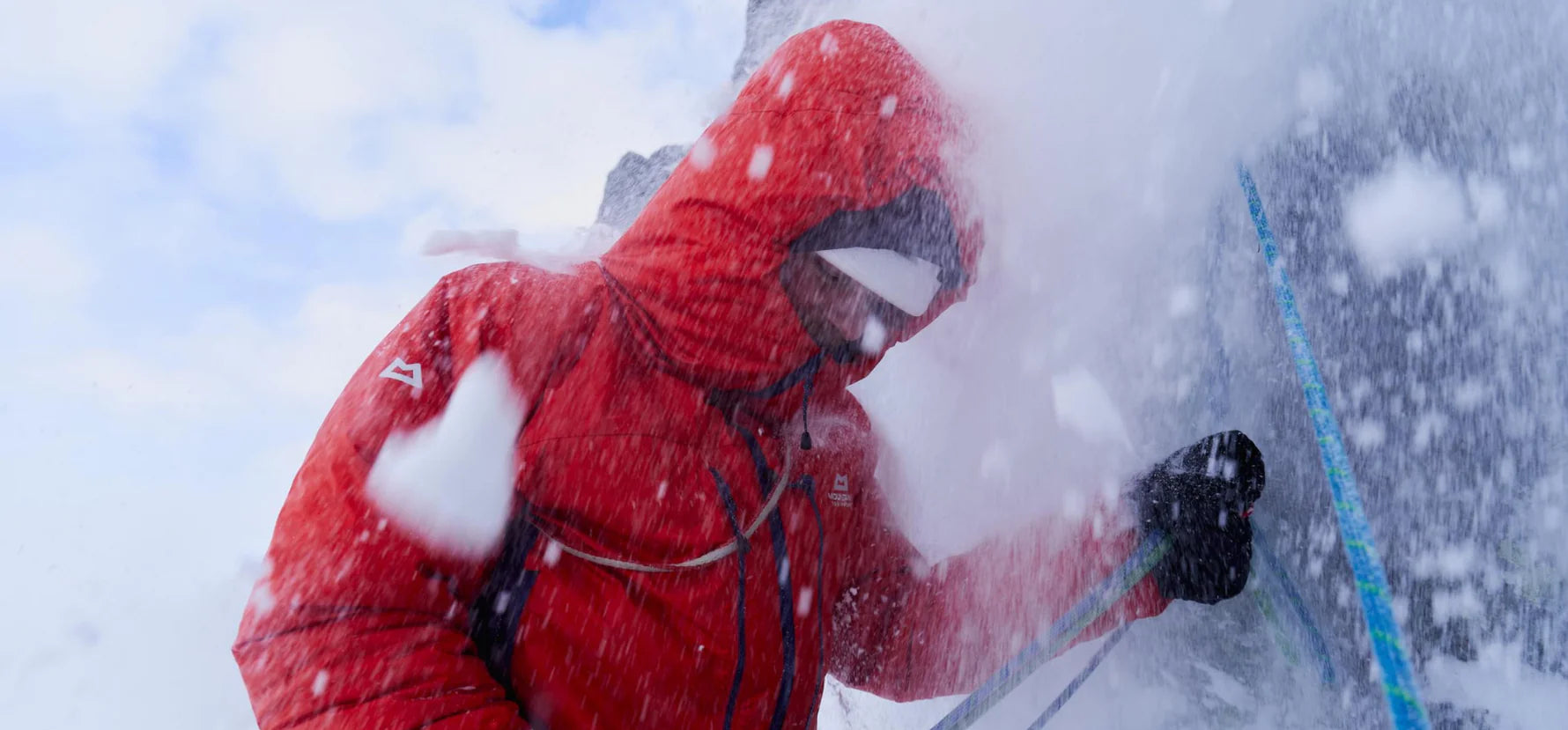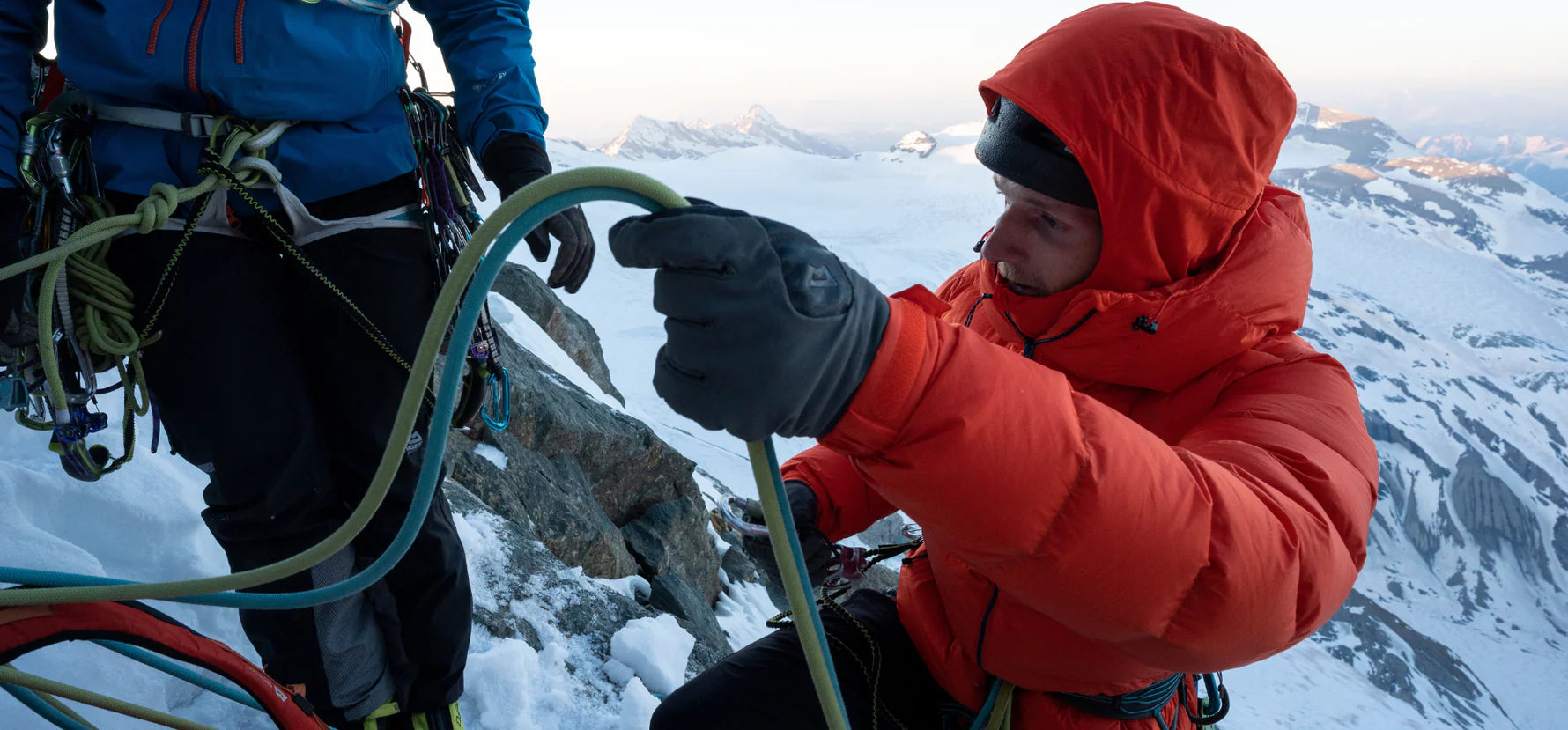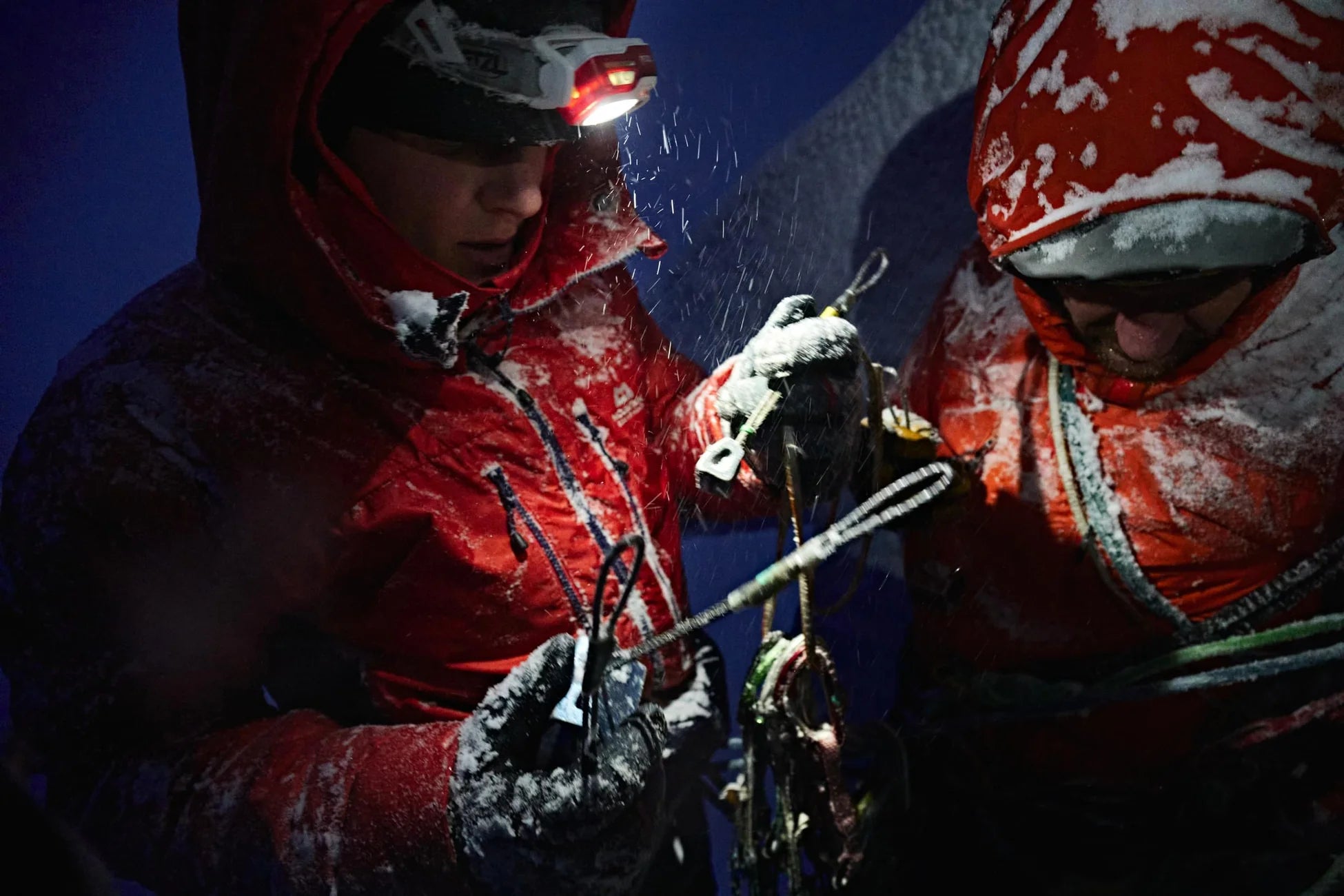Allgemeine Pflege
Deine Daunen- und Kunstfaserbekleidung wird dich garantiert viele Jahre lang begleiten. Mit der richtigen Pflege werden deine Lieblingsstücke sogar noch länger halten... Wenn deine Jacke im Einsatz ist - besonders auf längeren Touren und Reisen - lüfte sie, so oft es geht und trockne sie vor der Lagerung gründlich.
Wenn du deine Bekleidung nicht benutzt, lagere sie an einem kühlen, trockenen und dunklen Ort. Hänge Jacken auf oder lagere sie in einem luftigen Aufbewahrungsbeutel oder in einem Kissenbezug. Bitte nicht dauerhaft komprimiert in einem Packsack lagern!
Kleinere Flecken können in der Regel mit einem feuchten Tuch und milder Seife gereinigt werden. Waschen solltest du die Bekleidung nur, wenn es unbedingt erforderlich ist. Die Reißverschlüsse funktionieren besser, wenn du auch sie sauber hältst und pflegst.
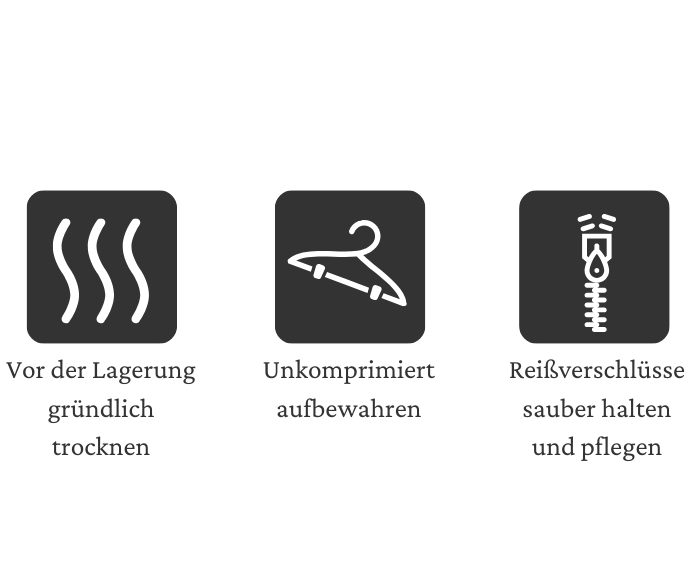
So wäschst du deine Daunenjacke
Einen Daunenjacke (oder Daunenhose) zu waschen und wieder zu trocknen ist zwar aufwändiger, als bei einem Pullover – aber dennoch kannst du es ganz einfach selbst erledigen. Die Wäsche erfordert allerdings etwas Zeit und Geduld – und einen Wäschetrockner.
Wenn es dir lieber ist, kannst du gerne auch unseren Waschservice nutzen. Das möchten wir dir nahelegen, wenn du keinen Wäschetrockner hast.
Bei allen Daunenprodukten ist nicht das Waschen die Herausforderung, sondern das Trocknen. Eine Daunenjacke kann in einer normalen Waschmaschine gewaschen und in einem haushaltsüblichen Wäschetrockner getrocknet werden. Alternativ kannst du sie auch von Hand waschen. Daunenbekleidung darf nicht chemisch gereinigt werden.
Idealerweise verwendest du für die Wäsche ein spezielles Daunenwaschmittel wie Grangers Down Wash, Nikwax Down Wash Direct, Storm Down Wash oder Fibertec Down Wash Eco. Es geht auch mit Neutralseife, diese ist aber nicht unsere erste Wahl. Benutze niemals Weichspüler oder Kombiwaschmittel mit Weichspüler.
Bevor es losgeht, solltest du deine Waschmaschine vorbereiten. Im Waschmittelfach dürfen sich keine Waschmittelreste befinden: Spüle die Schublade mit warmem Wasser aus, um verklebte Rückstände zu lösen.
Leere alle Taschen und lass deren Reißverschlüsse offen, damit auch die letzten Krümel ausgewaschen werden. Schließe den Frontreißverschluss. Lockere die Schnürzüge und schließe alle Klettverschlüsse.
Lies die Pflegehinweise auf dem Etikett. Auch wenn hier steht, dass nur Handwäsche empfohlen ist, kannst du die Daunenjacke – das richtige Waschprogramm vorausgesetzt! – in die Waschmaschine stecken. Wähle ein Programm wie Feinwäsche, Wollwäsche oder Handwäsche mit niedriger bis mittlerer Schleuderdrehzahl (max. 800 U/min) und mit einer Temperatur von 30°C. Nach Möglichkeit bitte nochmal extra spülen.
Nimm das Kleidungsstück nach dem Waschen bitte sehr vorsichtig aus der Waschmaschine. Das zusätzliche Gewicht der nassen Füllung könnte sonst die inneren Nähte beschädigen. Wenn du deine Jacke zum ersten Mal wäschst, wirst du jetzt wahrscheinlich erschrecken: Sie sieht platt und leer aus, die Daune ist völlig verklumpt. Aber keine Sorge! Das wird schon wieder... Die Jacke muss erstmal richtig trocknen!
So trocknest du deine Daunenbekleidung
Nach der Wäsche muss eine Daunenjacke gründlich getrocknet werden. Dafür solltest du dir und der Jacke genügend Zeit geben. Am Einfachsten gelingt es im Wäschetrockner, allerdings nur im Schonprogramm bzw. auf der niedrigsten Temperatur. Eine zu hohe Temperatur kann die Bezugsstoffe beschädigen.
Der Trocknungsvorgang kann unterstützt werden, wenn du ein paar Tennisbälle oder auch spezielle Trocknerbälle in die Trommel gibst. Bis deine Daunenjacke komplett durchgetrocknet ist, vergehen einige Stunden. Je mehr Füllung sie enthält, umso länger dauert es!
Nach dem ersten Durchgang im Trockner solltest du deine Jacke etwas abkühlen lassen. Breite sie dazu flach auf einem Wäscheständer aus. Wahrscheinlich spürst du jetzt immer noch verklumpte Daunen im Inneren. Schüttele die Jacke locker auf und löse die Daunenklumpen vorsichtig mit den Fingern. Du kannst sie nun für eine weitere Runde in den Trockner stecken – natürlich erneut im Schonprogramm! Lass sie danach wieder abkühlen, schüttle sie gut auf und taste erneut nach verbliebenen Daunenklümpchen. Wiederhole den Vorgang so oft es erforderlich ist. Die Daunen werden ihre natürliche Bauschkraft wieder zurückgewinnen! Es schadet nicht, wenn du die Jacke noch ein bis zwei Tage auf dem Wäscheständer liegen lässt, damit Restfeuchtigkeit verdunsten kann. Gönne ihr abschließend zum Auflockern der Füllung noch eine Runde im Trockner.
Jetzt kommen die Reißverschlüsse dran. Um Reißverschlüsse leichtgängig zu halten, pflege sie regelmäßig mit einem der folgenden Produkte: Gear Aid Zipper Lubricant, McNETT Zip Care oder Zipper Stick. Alternativ kannst du die Reißverschlüsse auf der ganzen Länge auch sparsam mit einer Wachskerze einreiben.
Minimierung der Daunenmigration
Die Bezugsstoffe unserer Daunenbekleidung und -schlafsäcke sind besonders dicht gewebt, um zu verhindern, dass Daunen oder kleinste Federteilchen die Stoffe durchdringen. Um die Daunendichtigkeit noch zu erhöhen, werden die Stoffe heiß gewalzt oder mit einer nur wenige Mikrometer dünnen Polymerschicht überzogen. Damit ist die Daunenmigration praktisch ausgeschlossen. Feinste Bestandteile der Füllung und dünne Federkiele finden gelegentlich trotzdem ihren Weg durch das Gewebe oder, was wahrscheinlicher ist, durch die Nähte. Federkiele sind relativ starr und können wie eine Nadel durch das Material dringen.
Wenn du also bemerkst, dass einzelne Daunen durch den Stoff austreten, ist das weder ein Grund zur Sorge noch ein Produktmangel. Wichtig: Zieh die Daune jetzt nicht aus dem Stoff heraus! Das winzige Loch würde unnötig ausgedehnt werden. Daunen sind zudem mit kleinsten Widerhaken miteinander verbunden – vermutlich käme gleich die nächste Daune hinterher. Versuche stattdessen, die Daune mit deinen Fingerspitzen von unten zu fassen und wieder ins Innere zu ziehen.

So wäschst du deine Kunstfaserjacke
Kunstfaserbekleidung ist vor allem beim Waschen und Trocknen pflegeleichter als daunengefüllte Bekleidung. Sie sollte aber trotzdem nur gewaschen werden, wenn es absolut notwendig ist. Natürlich sind auch deutliche Verschmutzungen oder ein strenger Geruch ein Zeichen dafür, dass es an der Zeit für eine Wäsche ist.
Am besten nimmst du dafür ein Spezialreinigungsmittel wie Grangers Performance Wash, Nikwax Tech Wash, Fibertec Pro Wash oder Storm Clothing Wash. Es geht auch mit Neutralseife, diese ist aber nicht unsere erste Wahl. Benutze niemals Weichspüler oder Kombiwaschmittel mit Weichspüler.
Bevor es losgeht, solltest du deine Waschmaschine vorbereiten. Im Waschmittelfach dürfen sich keine Waschmittelreste befinden: Spüle die Schublade mit warmem Wasser aus, um verklebte Rückstände zu lösen.
Leere alle Taschen und lass deren Reißverschlüsse offen, damit auch die letzten Krümel ausgewaschen werden. Schließe den Frontreißverschluss. Lockere die Schnürzüge und schließe alle Klettverschlüsse.
Lies die Pflegehinweise auf dem Etikett. Die Waschanleitung auf dieser Webseite ist die richtige für isolierte Kunstfaser Bekleidung von Mountain Equipment. Weicht das Pflegeetikett davon ab und du bist dir unsicher, kontaktiere unseren unseren Kundenservice. Wähle ein Programm wie Feinwäsche, Wollwäsche oder Handwäsche mit niedriger bis mittlerer Schleuderdrehzahl (max. 800 U/min) und mit einer Temperatur von 30°C. Nach Möglichkeit bitte nochmal extra spülen.
Nimm das Kleidungsstück nach dem Waschen bitte vorsichtig aus der Waschmaschine. Das zusätzliche Gewicht der nassen Füllung könnte die inneren Nähte beschädigen. Die meisten leichten Kleidungsstücke aus Synthetik lassen sich an der Luft trocknen. Bei schwereren Kleidungsstücken empfehlen wir die Verwendung eines Wäschetrockners. Verwende hier allerdings nur ein Schonprogramm bzw. eine niedrige Temperatur-Einstellung. Eine zu hohe Temperatur kann die Bezugsstoffe der Jacke beschädigen.
Jetzt kommen die Reißverschlüsse dran. Um Reißverschlüsse leichtgängig zu halten, pflege sie regelmäßig mit einem der folgenden Produkte: Gear Aid Zipper Lubricant, McNETT Zip Care oder Zipper Stick. Alternativ kannst du die Reißverschlüsse auf der ganzen Länge auch sparsam mit einer Wachskerze einreiben.
Reparaturen unterwegs
Auch wenn man noch so gut aufpasst: Funktionsbekleidung wird auf Kletter- und Bergtouren oft besonderen Belastungen ausgesetzt. Wie schnell ist mal ein Stück Stoff eingeklemmt, man bleibt an scharfkantigem Fels oder den Steigeisen hängen und der Oberstoff reißt ein. Derartige Schäden sind nicht durch unsere Garantie abgedeckt, sondern gehören zum normalen, wenn auch ärgerlichen, Verschleiß. Du kannst kleinere Malheure unterwegs selbst flicken oder dich nach deiner Tour an unseren Reparaturservice wenden.
-
Kleine Risse: Gaffa-Tape / Klebeband
Gaffa-Tape oder normales Klebeband, das über den Riss geklebt wird, kann kurzfristig helfen. Ein Tipp dazu: Schneide die Ecken des „Flicken“ rund, so hält das Tape länger auf dem Stoff. Das Obermaterial muss dabei sauber und trocken sein. Dies ist jedoch nur eine Notlösung – das Klebeband sollte baldmöglichst wieder entfernt und der Riss sorgfältig repariert werden.
-
Kleine bis mittelgroße Löcher: strapazierfähiges Tenacious Tape™ oder Betrafol® Tape
Spezial-Klebeband wie Tenacious Tape oder Betrafol® Tape kann bei der Reparatur größerer Löcher sehr hilfreich sein. Diese Tapes sind extrem robust und halten auch dauerhaft bei sehr niedrigen Temperaturen – sie hinterlassen aber Klebereste, die nach dem Abziehen kaum noch zu entfernen sind.
-
Austretende Füllung
Jede Feder oder Kunstfaser, die durch die Nähte oder den Stoff nach außen treten, sollten in das Kleidungsstück zurückgezogen werden. Wichtig: zieh Daunen oder Fasern nicht aus dem Stoff heraus! Das winzige Loch würde unnötig ausgedehnt werden.
-
Verklemmte oder schwergängige Reißverschlüsse
Reinige alle Reißverschlüsse regelmäßig mit warmem Seifenwasser. Sollte ein Reißverschluss doch mal verklemmt sein, versuche nicht ihn gewaltsam zu lösen. Reinigen und schmieren löst das Problem häufig schon. Untersuche auch den Reißverschlusskopf auf Schmutz oder Fremdkörper. Zur Reinigung kannst du eine alte Zahnbürste verwenden. Entdeckst du ausgerissene Zähne am Reißverschluss oder verbogene Metallteile am Schieber, ist er vermutlich nicht mehr zu retten. Nur eine professionelle Reparatur kann dies beheben: Melde dich bei unserem Reparaturservice.
Reparaturen vom Profi
Reißverschlüsse, Bezugsstoffe oder Schnürzüge sind von Verschleiß betroffen. Viele der häufigsten Schäden lassen sich professionell reparieren und die Lebensdauer deiner Bekleidung lässt sich dadurch deutlich verlängern!
Die meisten Reißverschlüsse kann man, genauso wie Schnürzüge, austauschen. Risse oder Löcher im Stoff können nahezu unsichtbar genäht und auch wieder mit wasserdichten Tapes verklebt werden. Melde dich bei unserem Reparaturservice, wenn du weitere Informationen brauchst.
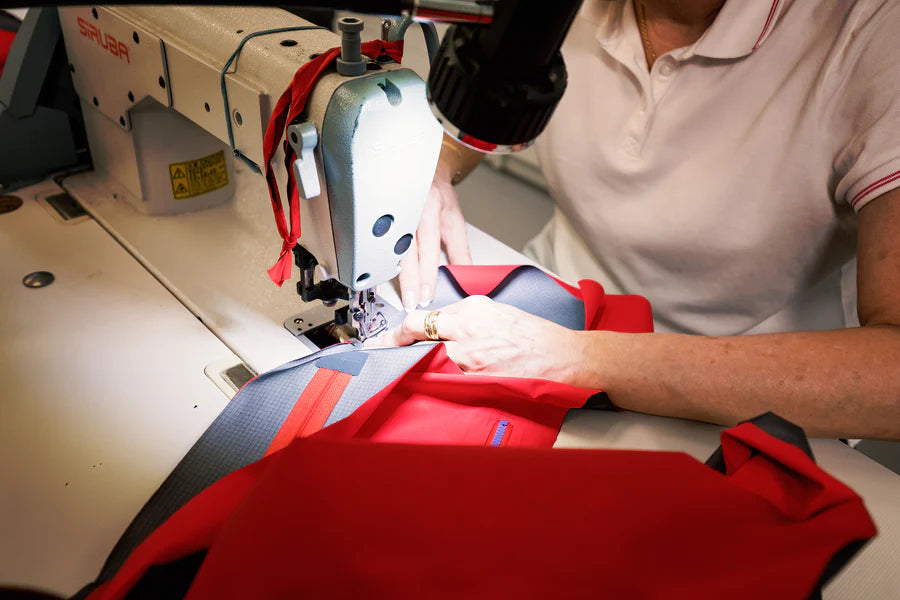
Reparaturen von Kunstfaserjacken
Synthetisch isolierte Bekleidung hält wirklich viel aus. Trotzdem können Löcher oder Risse im Stoff vorkommen. Reparaturen sind jedoch in der Regel etwas einfacher als bei Daunenbekleidung.
Löcher oder Risse kannst du mit Tape selbst auf die Schnelle reparieren: Gaffa-Band oder Klebeband ist keine dauerhafte Lösung, Tenacious Tape ist länger haltbar. Größere Risse benötigen spezielle Flicken, die wir teilweise zur Verfügung stellen können.
Melde dich bei unserem Reparaturservice, wenn du weitere Informationen brauchst.
Ende des Lebenszyklus
Isolierte Bekleidung sollte viele Jahre halten. Natürlich spielt die Beanspruchung und die Pflege eine entscheidende Rolle. Manche Komponenten verschleißen schneller, die Daunenfüllung jedoch hält eine halbe Ewigkeit. Kunstfaserfüllungen dagegen verlieren auch bei guter Pflege mit der Zeit an Loft und Wärmeleistung.
Wenn du merkst, dass deine Jacke die beste Zeit hinter sich hat, schau sie dir nochmal genau an und verwende sie bitte, bis sie quasi auseinanderfällt. Es mag sich komisch anhören, wenn wir als Hersteller so etwas sagen. Doch unsere isolierte Bekleidung enthält viele Komponenten und Materialien, deren Herstellung extrem energieintensiv ist. Wir möchten die Umweltbelastung durch unsere Produkte so gering wie möglich halten. Daher bitten wir dich, deine Bekleidung solange wie möglich zu nutzen und nicht zu früh zu ersetzen.
Hier noch ein paar Anregungen:
1) Wertschätzung - Unsere Produkte wollen eingesetzt werden. Jedes Abenteuer hinterlässt Spuren und spiegelt deine Erfahrungen wider. Das darf man auch sehen: Jeder Kratzer ist ein Statement.
2) Pflege - Wasche und pflege deine Bekleidung regelmäßig und bewahre sie sorgfältig auf. Ein platte Daunenjacke kann durch Waschen wieder zum Leben erweckt werden. Du kannst das selbst machen, oder unseren Waschservice nutzen. Unser Reparaturservice kann sogar Daune nachfüllen.
3) Reparieren - Kleinere Schäden können oft leicht behoben werden und bedeuten noch lange nicht das Ende deines Lieblingsteils. Natürlich kostet eine Reparatur Zeit und auch Geld – aber die Auswirkungen eines neu gekauften Produkts auf deinen Geldbeutel und auf die Umwelt sind deutlich höher.
4) Plan B - Auch wenn du deine Daunenjacke nicht mehr für ein Winterbiwak verwenden möchtest, kannst du jederzeit noch andere, weniger anspruchsvolle Abenteuer mit ihr erleben.
5) Plan C - Verwende dein Lieblingsteil in einem ganz anderen Umfeld. Lasse sie z.B. im Auto liegen, falls du mal eine Panne bei kaltem Wetter hast. Auch beim Schneeschaufeln bewährt sich eine gute, warme Jacke.
6) Weitergeben - Wenn du deine Ausrüstung wirklich nicht mehr verwenden willst, freut sich bestimmt noch jemand anderes darüber: Schenken macht ja bekanntlich Freu(n)de! Schau dich doch einfach mal in deinem Familien- und Freundeskreis um. Oder wende dich an Wohltätigkeits-Organisationen, die Outdoor-Ausrüstung annehmen und diese sinnvoll weitergeben.
7) Upcycle – Wenn gar nichts mehr geht: Die Komponenten, aus denen dein Produkt besteht, sind hochwertig und wertvoll. Materialien und Füllstoffe in dieser Qualität sind im Einzelhandel nicht erhältlich. Denk doch mal um die Ecke, ob du Teile deines Produktes noch anderweitig verwenden kannst? Aus der Kunstfaserfüllung kann noch ein Kissen entstehen. Mit der Daunenfüllung solltest du besonders vorsichtig umgehen: Es sei denn, du stehst auf Schneegestöber!
8) Recycle – Echtes Recycling spart Energie und Ressourcen, die sonst bei der Herstellung von neuem Material eingesetzt werden müssten.
Beim Textilrecycling ist die größte Hürde die Trennung der verschiedenen Komponenten wie Stoffe, Membrane, Fäden, Reißverschlüsse, Druckknöpfe etc. Hier ist kein richtiges Recycling, sondern nur Downcycling möglich, so werden z.B. geschredderte Textilien aus Altkleidercontainern zu Füll- und Dämmstoffen verarbeitet. Deine Kunstfaserjacken solltest du deshalb nicht mit dem Hausmüll entsorgen, sondern in einen Container einer Organisation werfen, die Fasern weiterverarbeiten kann.
Anders ist es bei Daunenprodukten: Der wertvollste Bestandteil ist die extrem langlebige Daune. Diese lässt sich unkompliziert vom Rest trennen - dazu reicht ein Cutter-Messer. So ist es möglich einen reinen Grundstoff für neue Produkte aufzubereiten. Bevor du also den Weg zum Container antrittst, schick dein Daunenprodukt gerne zu uns: In unserem DOWN CYCLE® Projekt werden 95% der Materialien recycelt.


